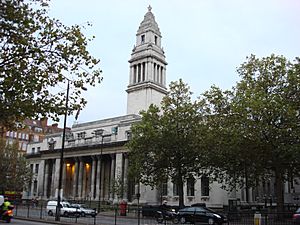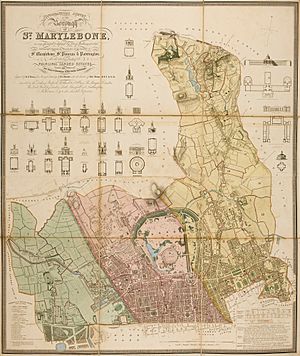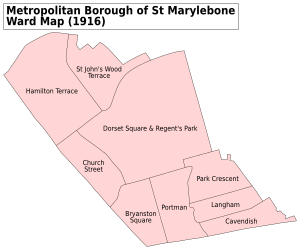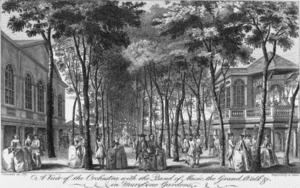Marylebone facts for kids
Quick facts for kids Marylebone |
|
|---|---|
 Marylebone Town Hall |
|
| OS grid reference | TQ285815 |
| London borough | |
| Ceremonial county | Greater London |
| Region | |
| Country | England |
| Sovereign state | United Kingdom |
| Post town | LONDON |
| Postcode district | W1 |
| Postcode district | NW1 |
| Dialling code | 020 |
| Police | Metropolitan |
| Fire | London |
| Ambulance | London |
| EU Parliament | London |
| UK Parliament |
|
| London Assembly | |
Marylebone (pronounced like MAR-li-bun) is a well-known area in London, England. It's located in the City of Westminster and is part of Central London and the West End. Its southern border is marked by Oxford Street, a famous shopping street.
Marylebone used to be an old parish and later a special borough called a metropolitan borough. In 1965, it joined with the boroughs of Westminster and Paddington to create the new City of Westminster.
Marylebone station, a train and tube station, is about two miles north-west of Charing Cross. Many other tube stations also serve the area, including Baker Street, Bond Street, Edgware Road (Bakerloo line), Edgware Road (Circle, District and Hammersmith & City lines), Great Portland Street, Marble Arch, Marylebone, Oxford Circus, and Regent's Park.
Contents
History of Marylebone
How Marylebone Got Its Name
Marylebone gets its name from a church dedicated to St Mary. This church, now known as St Marylebone Parish Church (built in 1817), was originally built near a small stream called the Tybourne or Tyburn. This stream started further north in what is now Swiss Cottage. It flowed along what is now Marylebone Lane, which still follows its winding path. The church and the area around it became known as "St Mary at the Bourne," which over time was shortened to Marylebone. Some people mistakenly think the name comes from the French "Marie la Bonne" (meaning "Mary the good"), but this is not true.
Early Days and Land Ownership
The area of Tyburn was mentioned in the Domesday Book in 1086. It was owned by Barking Abbey and was quite small, with fewer than 50 people living there. In the early 1200s, Robert de Vere, 3rd Earl of Oxford owned it.
Later, in the late 1400s, Thomas Hobson bought most of the land. In 1544, his son exchanged it with King Henry VIII. The King turned the northern part of the land into a Medieval deer park, which is now Regent's Park. The Tyburn land stayed with the Crown until 1611, when King James I sold the southern part.
Developing the Area
In 1710, John Holles, 1st Duke of Newcastle-upon-Tyne, bought the land. His daughter, Henrietta Harley, Countess of Oxford and Mortimer, inherited it. She married Edward Harley, 2nd Earl of Oxford and Earl Mortimer. They realized that London needed more stylish homes north of Oxford Road (now Oxford Street). So, they hired a surveyor named John Prince to create a plan for streets, including Cavendish Square.
The Harley family's heiress, Lady Margaret Cavendish Harley, married William Bentinck, 2nd Duke of Portland. This brought the property, including Marylebone High Street, into the Bentinck family. Many places in the area, like Cavendish Square and Portland Place, are named after the Dukes of Portland because of their land and building projects.
Today, large parts of Marylebone are still owned and managed by the Howard de Walden Estate and the Portman Estate. These estates have long histories with aristocratic families. The Howard de Walden Estate owns and manages most of the 92 acres in Marylebone, from Marylebone High Street to Robert Adam's Portland Place.
Pastimes and Changes
In the 1700s, Marylebone was known for its lively outdoor entertainment at Marylebone Gardens. These gardens hosted various shows and activities. The Crown bought back the northern part of the estate in 1813.
The Metropolitan Borough of St Marylebone was a local government area in London from 1899 to 1965. After that, it merged with the Metropolitan Borough of Paddington and the Metropolitan Borough of Westminster to form the larger City of Westminster.
Marylebone Streets
Marylebone has many main streets laid out in a grid pattern. These include Gloucester Place, Baker Street, Marylebone High Street, Wimpole Street, Harley Street, and Portland Place. Between these larger streets, you can find smaller, charming mews (lanes with old stables, now often homes).
Mansfield Street
Mansfield Street was built in 1770 by the Adam brothers. Many of its houses are beautiful buildings with fancy interiors. Famous architects like John Loughborough Pearson and Sir Edwin Lutyens lived here. Across the road, Alfred Waterhouse, who designed the Natural History Museum, also lived nearby.
Queen Anne Street
Queen Anne Street is an elegant street connecting Chandos Street with Welbeck Street. The famous painter JMW Turner lived at 47 Queen Anne Street from 1812 until he died in 1851. His house was known as "Turner's Den."
Chandos Street
During the same time, Chandos House in Chandos Street was used as the Austro-Hungarian Embassy. The ambassador, Prince Paul Anton III Esterhazy, held very grand parties there. This building is one of the best examples of Adam-style houses in London.
Wimpole Street
Wimpole Street runs from Henrietta Place north to Devonshire Street. At 2 Upper Wimpole, Arthur Conan Doyle, the creator of Sherlock Holmes, opened his eye doctor's practice in 1891. A six-story 18th-century house at 57 Wimpole Street was where Paul McCartney lived from 1964 to 1966. He stayed on the top floor of his girlfriend Jane Asher's family home. He and John Lennon even wrote "I Want to Hold Your Hand" on a piano in the basement there!
At number 50, the poet Elizabeth Barrett, later known as Elizabeth Barrett Browning, lived for some time between 1840 and 1845.
Bentinck Street
Bentinck Street connects Welbeck Street with the winding Marylebone Lane. Charles Dickens lived at number 18 with his father in the 1830s. Edward Gibbon wrote much of The Decline and Fall of the Roman Empire while living at number 7 in the 1770s. James Smithson, who founded the Smithsonian Institution, wrote his will at number 9 in 1826. The famous composer Frédéric Chopin briefly stayed at number 10 in 1848.
Marylebone also has connections to The Beatles. John Lennon had a flat at 34 Montagu Square, and the original Apple Corps headquarters were at 95 Wigmore Street.
Bulstrode Street
Bulstrode Street is a small, charming street named after a Portman family estate. It has been home to many healthcare professionals over the years. The famous actress Vivien Leigh was born at the Rahere Nursing Home, which was at number 8, in 1933.
New Cavendish Street
The north end of Welbeck Street meets New Cavendish Street. Number 13 New Cavendish Street was the birthplace in 1882 of the famous orchestral conductor Leopold Stokowski. He sang as a boy in the choir of St Marylebone Church.
Marylebone High Street Area
At the northern end of Marylebone High Street, near Marylebone Road, there's an area with a rich history. It once included the Marylebone Gardens, a cemetery, and a workhouse. Today, you'll find large apartment buildings and high-end shops there.
At 1 Dorset Street, the mid-Victorian scientist Charles Babbage, who invented an early computer, lived. He complained about the noise from nearby coach stands. Today, a venue for classical music, the Wigmore Hall, opened at 36 Wigmore Street in 1901. It hosts over 400 events each year.
Representation
Marylebone was represented by its own Member of Parliament (MP) in the UK Parliament from 1918 to 1983.
Today, the area is divided between two parliamentary constituencies: the Cities of London and Westminster and Westminster North. These areas are currently represented by Nickie Aiken and Karen Buck, respectively.
Geography of Marylebone
 |
Lisson Grove | St John's Wood | Regent's Park |  |
| Paddington | Fitzrovia | |||
| Hyde Park | Mayfair | Soho |
Some important places and features in Marylebone include:
- All Souls Church, Langham Place (designed by John Nash)
- Asia House, New Cavendish Street
- Baker Street (including the fictional 221B Baker Street from Sherlock Holmes)
- Broadcasting House (BBC headquarters)
- Bryanston Square
- Duke Street, Marylebone
- Harley Street (known for doctors' offices)
- Hinde Street Methodist Chapel
- Holy Trinity Church, Marylebone (designed by Sir John Soane)
- Hyde Park
- Langham Hotel, London (built in the 1860s)
- Madame Tussaud's (wax museum)
- Manchester Square (a Georgian square)
- Marble Arch
- Marylebone High Street
- Montagu Square (a Regency square)
- Regent's Park (which has London Zoo)
- Royal Academy of Music
- Royal Institute of British Architects
- Selfridges Department Store
- St. James's, Spanish Place
- St Peter, Vere Street (designed in 1722 by James Gibbs)
- University of Westminster
- Wallace Collection (a famous art museum)
- West London Mission at 19 Thayer Street
- Wigmore Hall (a concert venue)
- Wigmore Street
- Wyndham Place
Former Landmarks
- Egton House, a former studio for BBC Radio 1, which has been taken down.
- Queen's Hall, a classical music concert hall that was destroyed by fire during World War II.
- Marylebone Gardens, a former fun park and concert venue, closed in 1778.
- St. George's Hall, a theatre built in 1867, taken down in 1966.
- Yorkshire Stingo, a public house on Marylebone Road.
- St Marylebone Grammar School on the corner of Lisson Grove and Marylebone Road, now used as offices.
- Theatre Royal, Marylebone, a former music hall opened in 1832 at 71 Church Street, Marylebone, taken down in 1959.
- Freshwater Place off Homer Street, an early example of social housing by Octavia Hill, taken down in 1961.
Notable Residents
Many famous people have lived in or been connected to Marylebone:
- Lord Byron, a famous English romantic poet, was born in Marylebone and baptized at St Marylebone Parish Church.
- Charles Dickens, a well-known English writer, lived at 1 Devonshire Terrace.
- Benny Green, an English jazz saxophonist, was born in Marylebone.
- Robin Hurlstone, an English actor, was born in Marylebone.
- W. O. G. Lofts, an English researcher and author, was born in Marylebone.
- Paul McCartney, the English musician from The Beatles, wrote "Yesterday" while living at 57 Wimpole Street.
- Norman Wisdom, an English actor, comedian, musician, and singer, was born in Marylebone.
- Steve Wright, an English disc jockey and radio presenter, lived and died in Marylebone.
Transport in Marylebone
Tube Stations
Marylebone is well-connected by the London Underground (Tube) system. Here are the stations serving the area:
- Baker Street
- Bond Street
- Edgware Road (Bakerloo line)
- Edgware Road (Circle, District and Hammersmith & City lines)
- Great Portland Street
- Marble Arch
- Marylebone
- Oxford Circus
- Regent's Park
Railway Stations
- Marylebone is the main railway station in the area.
Bus Routes
Many bus routes serve Marylebone, making it easy to travel around London. These include routes 2, 13, 18, 27, 30, 74, 113, 139, 189, 205, 274, 453. There are also night bus routes N18 and N74.
Education in Marylebone
Marylebone is home to several well-known schools and universities:
- London Business School (a highly-ranked business school)
- Halcyon London International School (an international school on Seymour Place)
- St Marylebone School (a comprehensive school for girls, specializing in Performing Arts, Maths & Computing, founded in 1791)
- Sylvia Young Theatre School (a performing arts school)
- St Vincent's RC Primary School (a Catholic primary school)
- Francis Holland School (an independent day school for girls)
- Portland Place School (an independent secondary school)
- The Royal Academy of Music on Marylebone Road
- The University of Westminster on Marylebone Road and upper Regent Street
- Regent's College, located within Regent's Park, which includes:
- European Business School London
- British American College London
- Regent's Business School
- School of Psychotherapy and Counselling
- Webster Graduate School
- Internexus (English language courses)
- L'Ecole Internationale Franco-Anglaise (an international school offering English-French bilingual education)
- Queen's College Preparatory School (an independent day school for girls)
- Southbank International School on Portland Place
Images for kids
Error: no page names specified (help). In Spanish: Marylebone para niños
In Spanish: Marylebone para niños






